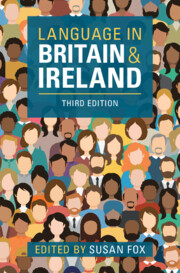Book contents
- Language in Britain and Ireland
- Language in Britain and Ireland
- Copyright page
- Contents
- Figures
- Tables
- Contributors
- Acknowledgements
- Map of Britain and Ireland
- Introduction
- Part I English
- Part II Multilingualism in Britain and Ireland: The Celtic Languages
- Part III Multilingualism in Britain and Ireland: Minority Languages
- Part IV Multilingualism: The Development of Urban Contact Varieties
- 21 Multicultural London English
- 22 British Asian English
- 23 Multicultural British English
- Part V Applied Sociolinguistic Issues
- Index
- References
23 - Multicultural British English
from Part IV - Multilingualism: The Development of Urban Contact Varieties
Published online by Cambridge University Press: 17 October 2024
- Language in Britain and Ireland
- Language in Britain and Ireland
- Copyright page
- Contents
- Figures
- Tables
- Contributors
- Acknowledgements
- Map of Britain and Ireland
- Introduction
- Part I English
- Part II Multilingualism in Britain and Ireland: The Celtic Languages
- Part III Multilingualism in Britain and Ireland: Minority Languages
- Part IV Multilingualism: The Development of Urban Contact Varieties
- 21 Multicultural London English
- 22 British Asian English
- 23 Multicultural British English
- Part V Applied Sociolinguistic Issues
- Index
- References
Summary
This chapter describes some of what we know so far about a possible Multicultural British English (MBE) by first explaining where it fits in terms of Multicultural London English (MLE) and how it has been labelled up to now. It draws upon research which has investigated varieties of English that appear to contain features of MLE, yet which are used outside of London. In doing so, it explores how local and supralocal linguistic features might work alongside features of MLE to create regional versions of an underlying variety of English, MBE, that exists in various locations across the UK. The chapter describes a few of the phonological, lexical and syntactic features of a Manchester-oriented MBE, before providing insights into the extent to which some of its speakers are aware of the language they use. Finally, the chapter discusses the role of grime music in the development and possible diffusion of MBE, and calls for further research to be carried out.
Keywords
- Type
- Chapter
- Information
- Language in Britain and Ireland , pp. 491 - 508Publisher: Cambridge University PressPrint publication year: 2024

